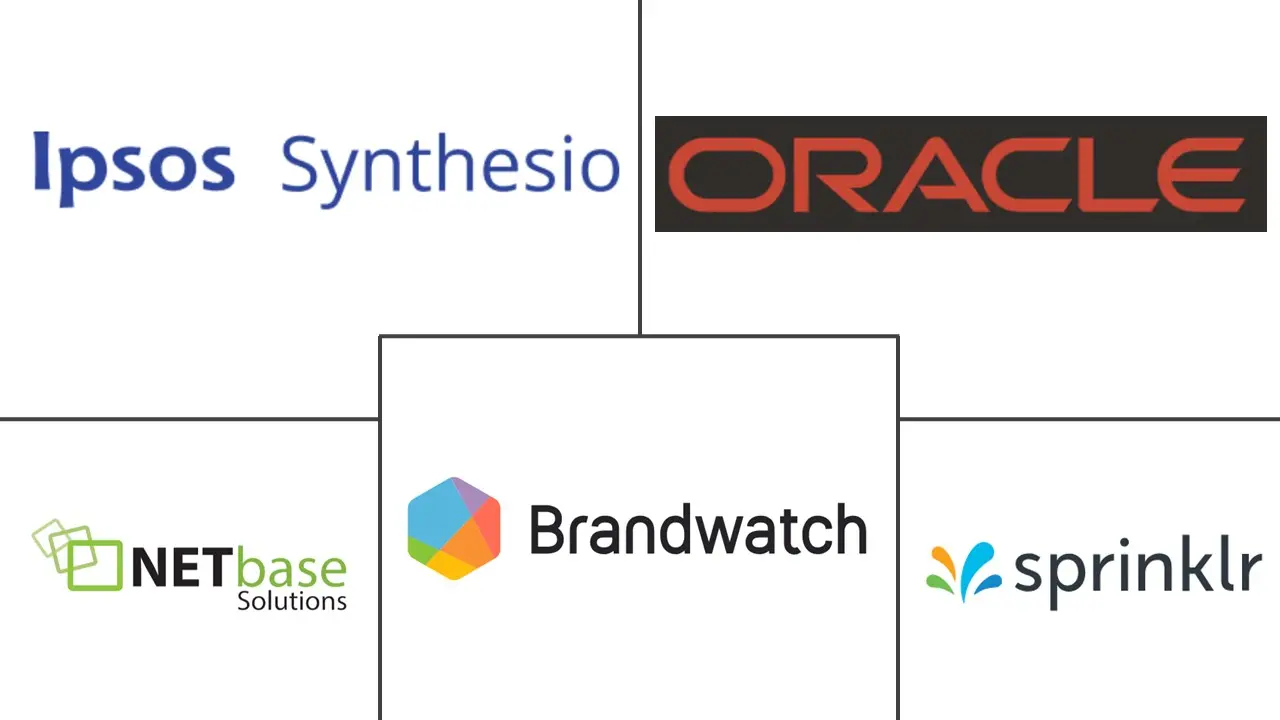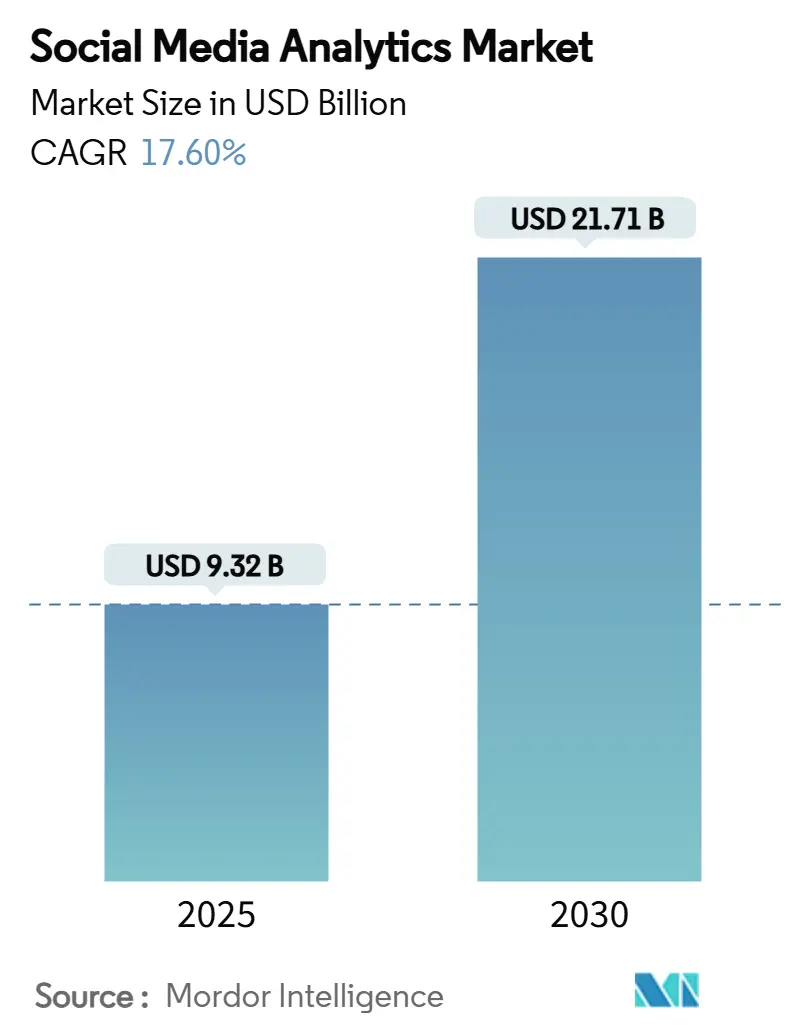
Social Media Analytics Market Analysis by Mordor Intelligence
The social media analytics market size stands at USD 9.32 billion in 2025 and is forecast to reach USD 21.71 billion by 2030, advancing at a 17.6% CAGR. Surging enterprise demand for real-time sentiment detection, predictive behavioral modeling, and campaign ROI measurement underpins this expansion. [1]Adobe Inc., “2025 AI and Digital Trends,” adobe.com Growth also reflects a decisive pivot from stand-alone brand monitoring toward unified, AI-driven insight engines that ingest text, image, audio, and video at scale. Accelerated cloud migration, the proliferation of social commerce, and fresh data-privacy mandates are reshaping solution roadmaps. Vendors able to combine multimodal processing, transparent model governance, and domain-specific data connectors are capturing share as buyers consolidate point tools into integrated customer-experience stacks. Competitive intensity remains high because switching costs are modest and proof-of-value cycles are short; as a result, product roadmaps emphasize continuous model retraining and embedded GenAI co-pilots to sustain differentiation.
Key Report Takeaways
- By component, Solutions led with 65% revenue share in 2024; Services are expanding at a 23.3% CAGR to 2030, reflecting the implementation complexity of GenAI use-cases.
- By deployment mode, Cloud reached 72% of the social media analytics market share in 2024 and is forecast to grow at a 21.8% CAGR as scalability needs rise.
- By module, Monitoring and Tracking held 56% share in 2024, while Measurement/Listening and Analytics record the fastest CAGR at 20.1% to 2030.
- By end-user industry, Retail and e-Commerce accounted for 22% of the social media analytics market size in 2024; Healthcare and Life-sciences is projected to advance at a 24.9% CAGR.
- By geography, North America commanded 38% of 2024 revenue; Asia-Pacific is the fastest growing region at a 21.3% CAGR through 2030.
Global Social Media Analytics Market Trends and Insights
Drivers Impact Analysis
| Driver | (~) % Impact on CAGR Forecast | Geographic Relevance | Impact Timeline |
|---|---|---|---|
| Exponential Growth of Number of Social Media Users | +4.2% | Global, with APAC leading growth | Medium term (2-4 years) |
| GenAI-powered Insight Engines Driving Upsell in North America | +3.8% | North America and EU | Short term (≤ 2 years) |
| Acceleration of In-App Social Commerce ROI Tracking | +3.1% | Global, concentrated in APAC and North America | Medium term (2-4 years) |
| Brand-safety Metric Mandates by Global Advertisers (US and EU) | +2.4% | North America and EU, spillover to APAC | Long term (≥ 4 years) |
| Source: Mordor Intelligence | |||
Exponential Growth of Number of Social Media Users
More than 5.24 billion individuals engage on social channels in 2025, expanding data volumes and pushing the social media analytics market toward scalable cloud architectures that parse billions of daily interactions. [2]Socialinsider Research, “2025 Social Media Benchmarks,” socialinsider.io Rising video-first engagement on TikTok, with 2.50% average interaction rates versus 0.50% on Instagram, forces vendors to embed image and video classifiers, displacing text-only sentiment tools. Healthcare providers leverage this user surge to track public health signals, with 90% of US adults sourcing health information on social platforms. Data diversity strengthens vendor lock-in because proprietary domain ontologies and language models improve accuracy over time. However, the need to de-duplicate bots and fake interactions escalates compute costs and necessitates continual algorithmic refinement.
GenAI-Powered Insight Engines Driving Upsell in North America
North American enterprises invest heavily in GenAI to transform passive monitoring into predictive guidance. Sixty-nine percent of regional marketers call GenAI revolutionary for content personalization. Advanced transformer models now detect misinformation with 99.68% accuracy, lifting overall data fidelity. Banking pilots that applied Long Short-Term Memory networks across 136,150 social posts achieved 91% customer-sentiment classification accuracy, enabling micro-segmented campaign offers. Yet only 12% of firms report clear GenAI ROI, creating advisory and managed-service opportunities for providers that can bridge the skills gap. Vendors rolling out low-code model-training interfaces and explainability dashboards are best positioned to capture expansion revenue.
Acceleration of In-App Social Commerce ROI Tracking
The social media analytics market responds to commerce-first platform design as TikTok, Instagram, and WeChat enable native checkout. US social commerce sales are poised to reach USD 80 billion in 2025, demanding real-time attribution models that clarify which creative, influencer, or discount closed a transaction. Asia-Pacific advertisers already allocate USD 77 billion to social placements, growing 15% annually, fuelling analytics demand for multi-touch funnel views. Commerce brands applying granular cohort analysis report 75% higher engagement, but must solve for SKU-level data harmonization across platforms. Vendors embedding product-ID stitching and lifetime-value repeat-purchase metrics strengthen renewal odds.
Brand-Safety Metric Mandates by Global Advertisers
EU Digital Services Act rules that took effect February 2024 require platforms to reveal content-moderation processes, boosting demand for audit-grade analytics that track adjacency risk and misinformation exposure. [3]European Commission, “Digital Services Act,” ec.europa.eu Imperial College research shows 37% of 2024 web traffic was malicious bot activity, up 5% over 2023. Advertisers now stipulate pre-bid avoidance of extremist or fraudulent content, pushing analytics engines to incorporate bot scoring and contextual classifiers. Vendors that certify to GARM standards and offer configurable brand-safety taxonomies enjoy preferred-vendor status on agency buying desks.
Restraints Impact Analysis
| Restraint | (~) % Impact on CAGR Forecast | Geographic Relevance | Impact Timeline |
|---|---|---|---|
| Stringent Privacy Regulations Limiting Data Granularity | -2.8% | EU and North America, expanding globally | Long term (≥ 4 years) |
| Analytics Skill-set Gap for Multimodal Data Interpretation Hinders the Market | -2.1% | Global, acute in emerging markets | Medium term (2-4 years) |
| Bot and Fake-traffic Distortion of Sentiment Metrics Hinders the Market | -1.7% | Global, concentrated in high-engagement platforms | Short term (≤ 2 years) |
| Source: Mordor Intelligence | |||
Stringent Privacy Regulations Limiting Data Granularity
GDPR enforcement cut third-party tracking capability by 14.79% for EU publishers, compelling platforms to devise privacy-preserving analytics such as federated learning. The California Consumer Privacy Act extends similar constraints across the United States. Meta’s “Pay or Okay” policy illustrates how consent frameworks reduce data availability and complicate cross-platform user stitching. Vendors able to deliver aggregated, cohort-level insights while preserving individual privacy comply with regulation and reduce client risk exposure.
Analytics Skill-Set Gap for Multimodal Data Interpretation
Transformer-based multimodal models require expertise in cross-modal fusion rarely found in traditional marketing teams. The 2024 MuSe Challenge recorded only a 0.3573 correlation coefficient on perception tasks, underscoring interpretive difficulty. [4]arXiv Contributors, “MuSe 2024 Multimodal Sentiment Analysis Challenge,” arxiv.org Scarce talent elongates deployment cycles and inflates total cost of ownership. Provider roadmaps prioritize automated feature engineering, drag-and-drop labeling, and managed-model services to close this capability gap.
Segment Analysis
By Component: Services Accelerate Despite Solutions Dominance
Solutions contributed 65% of 2024 revenue, underlining their role as the entry point to the social media analytics market. Subscription licenses provide predictable margins, yet enterprises now confront implementation backlogs that favor service engagements. Services are forecast to rise at a 23.3% CAGR as firms seek model calibration, taxonomy design, and regulatory mapping. This uptick illustrates how the social media analytics market size for implementation and optimization eclipses basic platform fees, especially when GenAI workflows demand bespoke prompt engineering. Sprinklr’s USD 796.4 million FY25 revenue, up from USD 618.2 million in FY23, showcases the dual-stream model of software plus advisory.
The momentum in professional services also stems from vertical compliance nuances. Healthcare clients require HIPAA alignment, while banking customers demand model explainability for credit-risk decisions. Providers that pool domain experts with data scientists reduce time-to-value and deepen wallet share. Consequently, advisory partners co-develop outcome-based pricing tied to conversion uplift or churn reduction, aligning incentives and boosting recurring revenue.
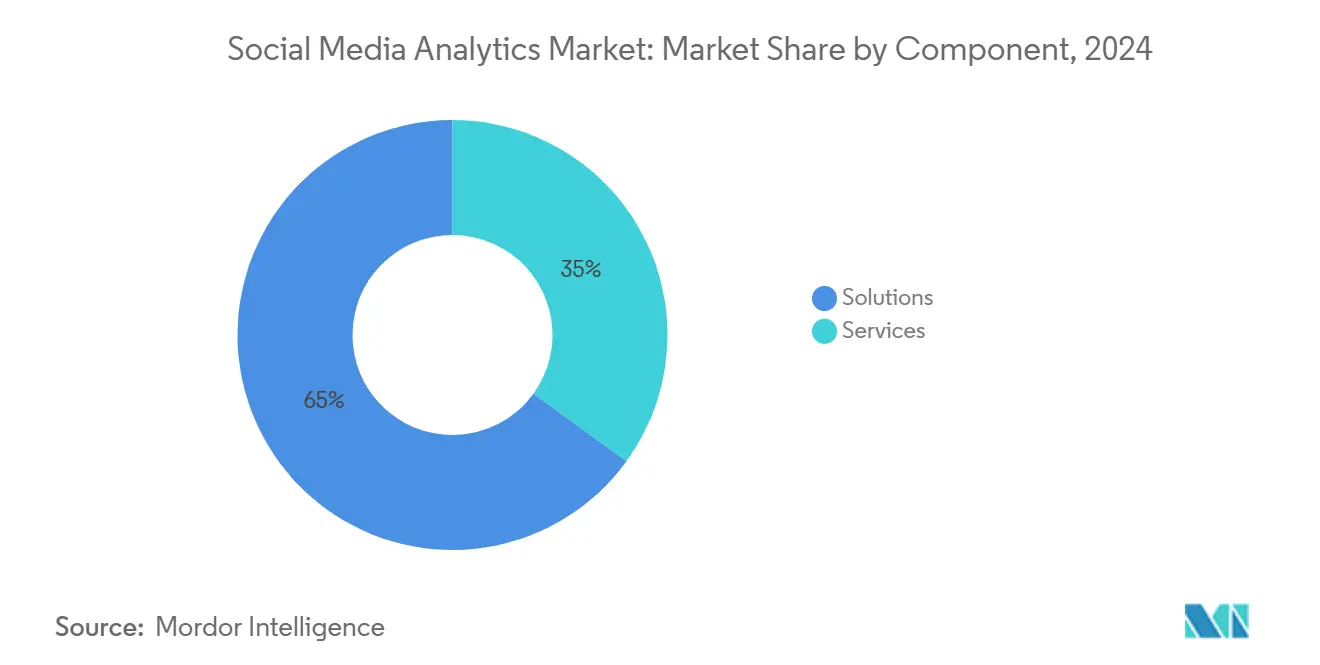
By Deployment Mode: Cloud Supremacy Reinforces Infrastructure Shift
Cloud captured 72% of the social media analytics market share in 2024 and is projected to sustain a 21.8% CAGR through 2030 on the strength of auto-scaling and managed security. Elastic GPU clusters process video streams and transformer models more cost-effectively than most on-premise alternatives. Hybrid options persist in sectors bound by data-residency rules, yet hyperscaler investment in regional zones lowers sovereignty barriers. The social media analytics market size for cloud workloads will therefore expand as real-time dashboards become board-level operational tools.
Cloud-native providers leverage continuous deployment to push weekly feature releases that refine bot-detection, language coverage, and compliance templates. Integration with broader data-warehouse ecosystems such as Snowflake and Databricks enables unified marketing, sales, and service visibility. Conversely, legacy on-premise installations struggle with model-versioning and patch latency, increasing operational risk.
By Module: Measurement Analytics Gains Despite Monitoring Leadership
Monitoring and Tracking retains 56% revenue share because brand-mention alerts and crisis detection remain table stakes. Nonetheless, Measurement/Listening and Analytics is forecast to expand at 20.1% CAGR as executives demand proof that campaigns translate into pipeline, basket size, or patient outcomes. The social media analytics market size for predictive modules is rising because GenAI compresses analysis latency from days to minutes. Banking projects already report 91% classification accuracy, enabling same-day service recovery.
Growth is also fueled by cross-channel attribution. As commerce functionality embeds into social feeds, marketers insist on SKU-level lift reports. Measurement modules now incorporate identity resolution graphs and product-catalog integrations. Vendors offering unified tagging across paid, earned, and owned media enjoy cross-sell momentum, lifting average contract value.
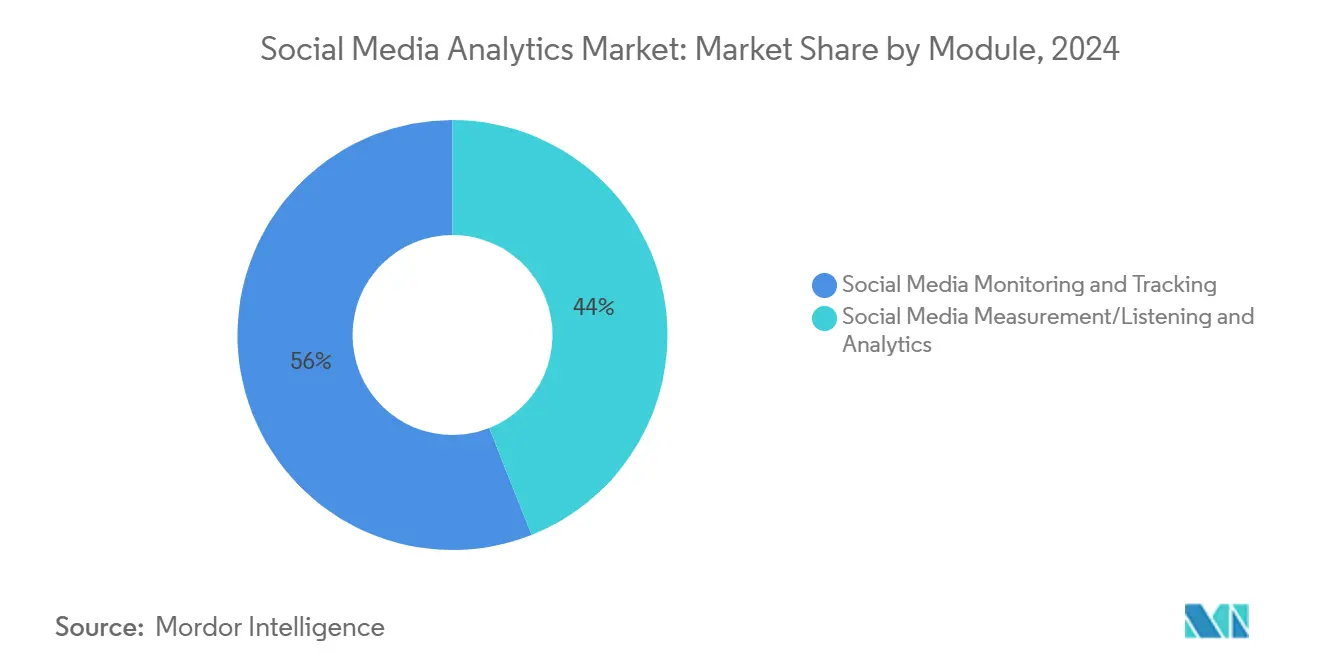
By End-User Industry: Healthcare Surge Challenges Retail Leadership
Retail and e-Commerce accounted for 22% of 2024 revenue thanks to early adoption of influencer analytics and social-commerce checkout. Yet Healthcare and Life-sciences is projected to lead expansion with a 24.9% CAGR as hospitals monitor patient sentiment, vaccine discourse, and care-path adherence. This shift indicates a broader diffusion of the social media analytics industry into mission-critical workflows. Population-health initiatives depend on near-real-time detection of outbreak chatter, while pharmaceutical firms track adverse-event mentions under strict pharmacovigilance guidelines.
For retailers, first-party data deprecation post-cookie accelerates reliance on social datasets for personalization. By contrast, healthcare institutions value clinical accuracy and data security. Providers responding with HIPAA-compliant pipelines and medical entity recognition models capture share. Cross-industry learning occurs as retail A/B testing methodologies inform patient-engagement optimization, while healthcare privacy safeguards influence retail consent frameworks.
Geography Analysis
North America led the social media analytics market with 38% revenue in 2024, buoyed by sophisticated digital-ad ecosystems and early GenAI rollouts. More than 75% of US ad expenditure is online, driving pervasive use of social listening tools within omnichannel campaign orchestration. Enterprises face rising compliance overhead due to state-level privacy statutes, prompting demand for policy-aware analytics frameworks. Despite maturity, growth continues as brands extend usage from marketing into risk, investor relations, and workplace culture assessment.
Asia-Pacific posts the highest regional CAGR at 21.3% through 2030 as mobile-first populations adopt social commerce at scale. The region’s USD 77 billion social-media ad spend in 2024, up 15% year over year, anchors investment in cross-language sentiment and influencer fraud detection. China’s ecosystem innovation—such as Taobao’s live-stream selling—spills over to Southeast Asia, creating green-field analytics demand. India’s multilingual diversity further necessitates adaptable ontologies, spurring local-language model development partnerships.
Europe records steady growth because GDPR and the Digital Services Act force enterprises to seek compliant analytics alternatives rather than abandon insight generation. Vendors that embed consent management, on-device processing, and differential-privacy reporting expand pipeline among cautious buyers. Meanwhile, Latin America, Middle East, and Africa begin adopting off-the-shelf cloud analytics as internet penetration rises. Urban clusters in Brazil and the Gulf states mirror advanced market behaviors, accelerating social media analytics market adoption without incurring heavy localization expenditure.

Competitive Landscape
The social media analytics market remains moderately fragmented; the top five vendors hold well under 40% combined revenue, preserving buyer leverage. Incumbent enterprise-software providers capitalize on installed bases to cross-sell analytics modules, while venture-backed specialists compete on depth of AI research. Product strategy now revolves around multimodal ingestion, explainable models, and pre-built compliance kits for healthcare, finance, and public sector.
Sprinklr demonstrates the value of platform breadth: FY25 revenue climbed to USD 796.4 million by delivering marketing, service, and research on one stack. Adobe amplifies Creative Cloud assets with social listening add-ons that feed generative-design tools, shortening content cycles. Challenger firms such as Dataminr exploit high-frequency news detection to serve security and crisis-management use cases. Meanwhile, AI-native start-ups integrate OpenAI APIs to provide conversational analytics in hours rather than weeks, threatening legacy renewal rates.
Strategic partnerships shape differentiation. Oracle aligns with TikTok for commerce attribution, while Google Cloud’s Vertex AI accelerates model deployment within Talkwalker. Vertical specialization also intensifies: Brandwatch pursues consumer-goods benchmarks, whereas YouScan targets visual-logo detection for automotive brands. Consolidation pressure is rising as private-equity investors seek platform roll-ups to achieve scale efficiencies.
Social Media Analytics Industry Leaders
-
Sprinklr
-
Oracle Corporation
-
Synthesio (Crimson Hexagon)
-
Brandwatch
-
NetBase Solutions Inc.
- *Disclaimer: Major Players sorted in no particular order
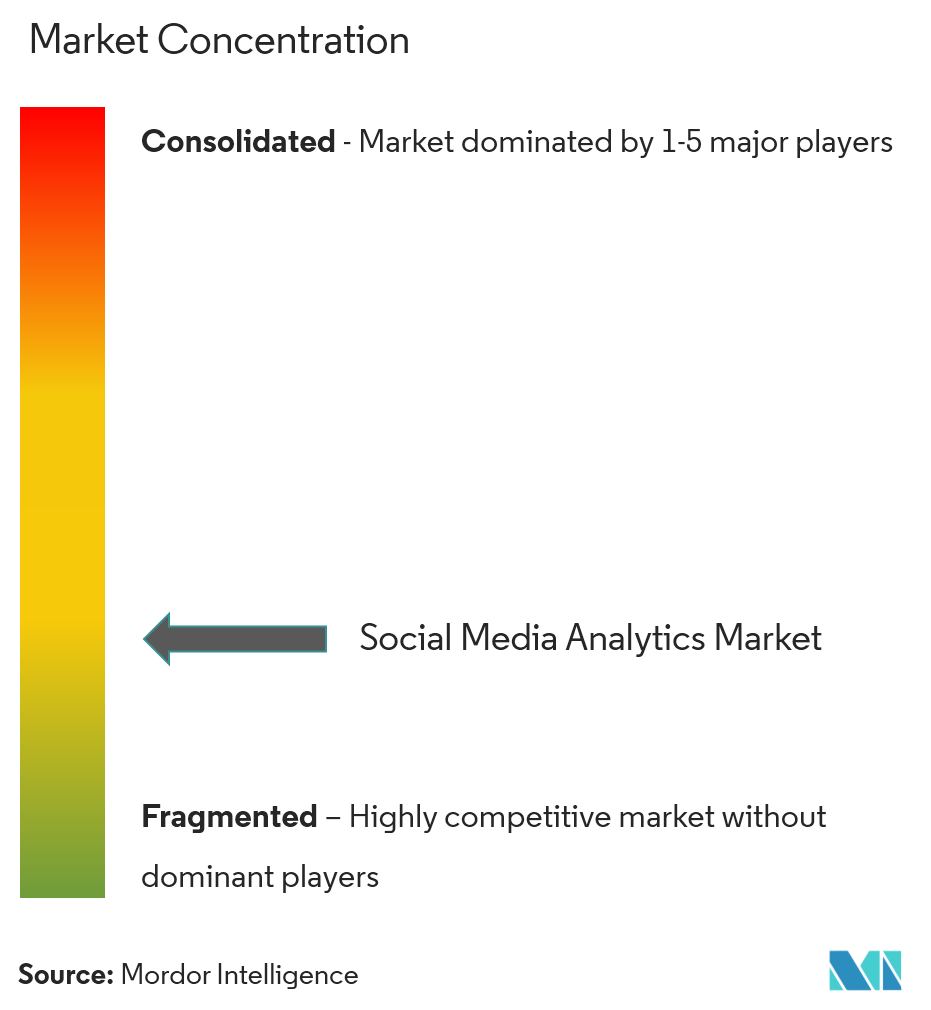
Recent Industry Developments
- March 2025: Sprinklr disclosed FY25 revenue of USD 796.4 million, up 28.8% over FY23, reflecting its strategy to fuse unified experience data with generative AI to deepen cross-sell into existing Fortune 100 accounts.
- February 2025: Adobe’s 2025 AI and Digital Trends report showed 65% of executives flag AI as central to growth yet only 12% realize ROI, validating service-provider opportunities in model operationalization.
- January 2025: PR Newswire reported 77% more media reprints for its Asia-Pacific Enhanced Release service, evidencing publisher appetite for analytics-rich content distribution that boosts discoverability.
- December 2024: IPG MAGNA estimated Asia-Pacific advertising spend at USD 289 billion, with social platforms capturing USD 77 billion—data that reinforces regional expansion bets by analytics suppliers.
Global Social Media Analytics Market Report Scope
Social media analytics combines monitoring, measurement, and analysis tools to uncover user sentiments and identify key trends in the studied market. The deployment of social media analytics allows users to mine and decipher vast amounts of data from various social media platforms, such as Facebook, Twitter, and Instagram, among others. It helps companies to discover customer sentiment about brands, trends, customer concerns, the efficacy of the organization's marketing campaigns, and competitor intelligence.
The Social Media Analytics Market is segmented by By Type ((Software (SaaS and On-premise), Services (Professional and Managed)), Module (Social Media Monitoring and Tracking, Social Media Measurement/Listening and Analytics), End-user Industry (Media and Entertainment, IT and Telecom, BFSI, Retail (including E-commerce), Travel and Hospitality, Other End-user Industries (Healthcare, Public Services, etc.)) and Geography (North America, Europe, Asia-Pacific, Latin America, and Middle East and Africa). The market sizes and forecasts are provided in terms of value (USD million) for all the above segments.
| Solutions |
| Services |
| Cloud |
| On-premise |
| Social Media Monitoring and Tracking |
| Social Media Measurement/Listening and Analytics |
| Media and Entertainment |
| IT and Telecom |
| BFSI |
| Retail and e-Commerce |
| Travel and Hospitality |
| Healthcare and Life-sciences |
| Other End-user Industries |
| North America | United States | |
| Canada | ||
| Mexico | ||
| Europe | United Kingdom | |
| Germany | ||
| France | ||
| Italy | ||
| Spain | ||
| Rest of Europe | ||
| Asia-Pacific | China | |
| India | ||
| Japan | ||
| South Korea | ||
| Rest of Asia-Pacific | ||
| South America | Brazil | |
| Argentina | ||
| Rest of South America | ||
| Middle East and Africa | Middle East | GCC |
| Turkey | ||
| Israel | ||
| Rest of Middle East | ||
| Africa | South Africa | |
| Nigeria | ||
| Rest of Africa | ||
| By Component | Solutions | ||
| Services | |||
| By Deployment Mode | Cloud | ||
| On-premise | |||
| By Module | Social Media Monitoring and Tracking | ||
| Social Media Measurement/Listening and Analytics | |||
| By End-user Industry | Media and Entertainment | ||
| IT and Telecom | |||
| BFSI | |||
| Retail and e-Commerce | |||
| Travel and Hospitality | |||
| Healthcare and Life-sciences | |||
| Other End-user Industries | |||
| By Geography | North America | United States | |
| Canada | |||
| Mexico | |||
| Europe | United Kingdom | ||
| Germany | |||
| France | |||
| Italy | |||
| Spain | |||
| Rest of Europe | |||
| Asia-Pacific | China | ||
| India | |||
| Japan | |||
| South Korea | |||
| Rest of Asia-Pacific | |||
| South America | Brazil | ||
| Argentina | |||
| Rest of South America | |||
| Middle East and Africa | Middle East | GCC | |
| Turkey | |||
| Israel | |||
| Rest of Middle East | |||
| Africa | South Africa | ||
| Nigeria | |||
| Rest of Africa | |||
Key Questions Answered in the Report
What is the current value of the social media analytics market?
The market is valued at USD 9.32 billion in 2025 and is projected to reach USD 21.71 billion by 2030.
Which region will grow the fastest through 2030?
Asia-Pacific is forecast to post a 21.3% CAGR due to mobile-first social-commerce adoption and rising ad budgets.
Why are services growing faster than software licenses?
Enterprises need expert support for GenAI tuning, compliance mapping, and multimodal data integration, pushing Services to a 23.3% CAGR.
How are privacy regulations affecting analytics capabilities?
GDPR and state-level US laws reduce data granularity, driving demand for privacy-preserving analytics that rely on federated learning and aggregated reporting.
Which end-user industry shows the highest growth potential?
Healthcare and Life-sciences is projected to expand at a 24.9% CAGR as providers adopt social listening for patient engagement and public-health surveillance.
What emerging feature differentiates leading platforms?
Embedded GenAI co-pilots that convert raw social signals into predictive guidance and creative recommendations are becoming must-have capabilities.
Page last updated on:
